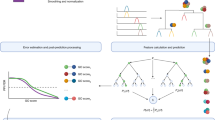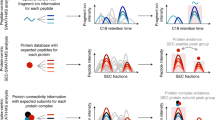Abstract
Affinity purification coupled with mass spectrometry (AP-MS) is a widely used approach for the identification of protein-protein interactions. However, for any given protein of interest, determining which of the identified polypeptides represent bona fide interactors versus those that are background contaminants (for example, proteins that interact with the solid-phase support, affinity reagent or epitope tag) is a challenging task. The standard approach is to identify nonspecific interactions using one or more negative-control purifications, but many small-scale AP-MS studies do not capture a complete, accurate background protein set when available controls are limited. Fortunately, negative controls are largely bait independent. Hence, aggregating negative controls from multiple AP-MS studies can increase coverage and improve the characterization of background associated with a given experimental protocol. Here we present the contaminant repository for affinity purification (the CRAPome) and describe its use for scoring protein-protein interactions. The repository (currently available for Homo sapiens and Saccharomyces cerevisiae) and computational tools are freely accessible at http://www.crapome.org/.
This is a preview of subscription content, access via your institution
Access options
Subscribe to this journal
Receive 12 print issues and online access
$259.00 per year
only $21.58 per issue
Buy this article
- Purchase on SpringerLink
- Instant access to full article PDF
Prices may be subject to local taxes which are calculated during checkout




Similar content being viewed by others
References
Gingras, A.C., Gstaiger, M., Raught, B. & Aebersold, R. Analysis of protein complexes using mass spectrometry. Nat. Rev. Mol. Cell Biol. 8, 645–654 (2007).
Selbach, M. & Mann, M. Protein interaction screening by quantitative immunoprecipitation combined with knockdown (QUICK). Nat. Methods 3, 981–983 (2006).
Trinkle-Mulcahy, L. et al. Identifying specific protein interaction partners using quantitative mass spectrometry and bead proteomes. J. Cell Biol. 183, 223–239 (2008).
Trinkle-Mulcahy, L. Resolving protein interactions and complexes by affinity purification followed by label-based quantitative mass spectrometry. Proteomics 12, 1623–1638 (2012).
Tackett, A.J. et al. I-DIRT, a general method for distinguishing between specific and nonspecific protein interactions. J. Proteome Res. 4, 1752–1756 (2005).
Dunham, W.H., Mullin, M. & Gingras, A.C. Affinity-purification coupled to mass spectrometry: basic principles and strategies. Proteomics 12, 1576–1590 (2012).
Hubner, N.C. et al. Quantitative proteomics combined with BAC TransgeneOmics reveals in vivo protein interactions. J. Cell Biol. 189, 739–754 (2010).
Nesvizhskii, A.I. Computational and informatics strategies for identification of specific protein interaction partners in affinity purification mass spectrometry experiments. Proteomics 12, 1639–1655 (2012).
Sardiu, M.E. et al. Probabilistic assembly of human protein interaction networks from label-free quantitative proteomics. Proc. Natl. Acad. Sci. USA 105, 1454–1459 (2008).
Skarra, D.V. et al. Label-free quantitative proteomics and SAINT analysis enable interactome mapping for the human Ser/Thr protein phosphatase 5. Proteomics 11, 1508–1516 (2011).
Al-Hakim, A.K., Bashkurov, M., Gingras, A.C., Durocher, D. & Pelletier, L. Interaction proteomics identify NEURL4 and the HECT E3 ligase HERC2 as novel modulators of centrosome architecture. Mol. Cell. Proteomics 11, M111.014233 (2012).
Chen, G.I. et al. PP4R4/KIAA1622 forms a novel stable cytosolic complex with phosphoprotein phosphatase 4. J. Biol. Chem. 283, 29273–29284 (2008).
Cristea, I.M., Williams, R., Chait, B.T. & Rout, M.P. Fluorescent proteins as proteomic probes. Mol. Cell. Proteomics 4, 1933–1941 (2005).
Daniels, D.L. et al. Examining the complexity of human RNA polymerase complexes using HaloTag technology coupled to label free quantitative proteomics. J. Proteome Res. 11, 564–575 (2012).
Dunham, W.H. et al. A cost-benefit analysis of multidimensional fractionation of affinity purification-mass spectrometry samples. Proteomics 11, 2603–2612 (2011).
Ewing, R.M. et al. Large-scale mapping of human protein-protein interactions by mass spectrometry. Mol. Syst. Biol. 3, 89 (2007).
Forget, D. et al. The protein interaction network of the human transcription machinery reveals a role for the conserved GTPase RPAP4/GPN1 and microtubule assembly in nuclear import and biogenesis of RNA polymerase II. Mol. Cell. Proteomics 9, 2827–2839 (2010).
Goudreault, M. et al. A PP2A phosphatase high density interaction network identifies a novel striatin-interacting phosphatase and kinase complex linked to the cerebral cavernous malformation 3 (CCM3) protein. Mol. Cell. Proteomics 8, 157–171 (2009).
Kean, M.J. et al. Structure-function analysis of core STRIPAK proteins: a signaling complex implicated in Golgi polarization. J. Biol. Chem. 286, 25065–25075 (2011).
Kruiswijk, F. et al. Coupled activation and degradation of eEF2K regulates protein synthesis in response to genotoxic stress. Sci. Signal. 5, ra40 (2012).
Sato, S. et al. A set of consensus mammalian mediator subunits identified by multidimensional protein identification technology. Mol. Cell 14, 685–691 (2004).
de Lau, W. et al. Lgr5 homologues associate with Wnt receptors and mediate R-spondin signalling. Nature 476, 293–297 (2011).
Greco, T.M., Yu, F., Guise, A.J. & Cristea, I.M. Nuclear import of histone deacetylase 5 by requisite nuclear localization signal phosphorylation. Mol. Cell. Proteomics 10, M110.004317 (2011).
Tsai, Y.C., Greco, T.M., Boonmee, A., Miteva, Y. & Cristea, I.M. Functional proteomics establishes the interaction of SIRT7 with chromatin remodeling complexes and expands its role in regulation of RNA polymerase I transcription. Mol. Cell. Proteomics 11, M111.015156 (2012).
Rudashevskaya, E.L. et al. A method to resolve the composition of heterogeneous affinity-purified protein complexes assembled around a common protein by chemical cross-linking, gel electrophoresis and mass spectrometry. Nat. Protoc. 8, 75–97 (2013).
Pichlmair, A. et al. Viral immune modulators perturb the human molecular network by common and unique strategies. Nature 487, 486–490 (2012).
Varjosalo, M. et al. Interlaboratory reproducibility of large-scale human protein-complex analysis by standardized AP-MS. Nat. Methods 10, 307–314 (2013).
Breitkreutz, A. et al. A global protein kinase and phosphatase interaction network in yeast. Science 328, 1043–1046 (2010).
Choi, H. et al. SAINT: probabilistic scoring of affinity purification–mass spectrometry data. Nat. Methods 8, 70–73 (2011).
Choi, H. et al. Analyzing protein-protein interactions from affinity purification-mass spectrometry data with SAINT. Curr. Protoc. Bioinformatics 39, 8.15 (2012).
Razick, S., Magklaras, G. & Donaldson, I.M. iRefIndex: a consolidated protein interaction database with provenance. BMC Bioinformatics 9, 405 (2008).
Thakur, S.S. et al. Deep and highly sensitive proteome coverage by LC-MS/MS without prefractionation. Mol. Cell Proteomics 10, M110.003699 (2011).
Shen, Z. et al. A WD-repeat protein stabilizes ORC binding to chromatin. Mol. Cell 40, 99–111 (2010).
Chen, G.I. & Gingras, A.C. Affinity-purification mass spectrometry (AP-MS) of serine/threonine phosphatases. Methods 42, 298–305 (2007).
Gingras, A.C. et al. A novel, evolutionarily conserved protein phosphatase complex involved in cisplatin sensitivity. Mol. Cell Proteomics 4, 1725–1740 (2005).
Keller, A., Nesvizhskii, A.I., Kolker, E. & Aebersold, R. Empirical statistical model to estimate the accuracy of peptide identifications made by MS/MS and database search. Anal. Chem. 74, 5383–5392 (2002).
Nesvizhskii, A.I., Keller, A., Kolker, E. & Aebersold, R. A statistical model for identifying proteins by tandem mass spectrometry. Anal. Chem. 75, 4646–4658 (2003).
Deutsch, E.W. et al. A guided tour of the Trans-Proteomic Pipeline. Proteomics 10, 1150–1159 (2010).
Pruitt, K.D., Tatusova, T., Brown, G.R. & Maglott, D.R. NCBI Reference Sequences (RefSeq): current status, new features and genome annotation policy. Nucleic Acids Res. 40, D130–D135 (2012).
Craig, R. & Beavis, R.C. TANDEM: matching proteins with tandem mass spectra. Bioinformatics 20, 1466–1467 (2004).
Nesvizhskii, A.I. & Aebersold, R. Interpretation of shotgun proteomic data: the protein inference problem. Mol. Cell. Proteomics 4, 1419–1440 (2005).
Fermin, D., Basrur, V., Yocum, A.K. & Nesvizhskii, A.I. Abacus: a computational tool for extracting and pre-processing spectral count data for label-free quantitative proteomic analysis. Proteomics 11, 1340–1345 (2011).
Huang, D.W., Sherman, B.T. & Lempicki, R.A. Systematic and integrative analysis of large gene lists using DAVID bioinformatics resources. Nat. Protoc. 4, 44–57 (2009).
de Hoon, M.J., Imoto, S., Nolan, J. & Miyano, S. Open source clustering software. Bioinformatics 20, 1453–1454 (2004).
Page, R.D. TreeView: an application to display phylogenetic trees on personal computers. Comput. Appl. Biosci. 12, 357–358 (1996).
Kasprzyk, A. BioMart: driving a paradigm change in biological data management. Database (Oxford) 2011, bar049 (2011).
Tzivion, G., Luo, Z. & Avruch, J. A dimeric 14-3-3 protein is an essential cofactor for Raf kinase activity. Nature 394, 88–92 (1998).
Wartmann, M. & Davis, R.J. The native structure of the activated Raf protein kinase is a membrane-bound multi-subunit complex. J. Biol. Chem. 269, 6695–6701 (1994).
Gingras, A.C., Raught, B. & Sonenberg, N. eIF4 initiation factors: effectors of mRNA recruitment to ribosomes and regulators of translation. Annu. Rev. Biochem. 68, 913–963 (1999).
Miki, H., Miura, K. & Takenawa, T. N-WASP, a novel actin-depolymerizing protein, regulates the cortical cytoskeletal rearrangement in a PIP2-dependent manner downstream of tyrosine kinases. EMBO J. 15, 5326–5335 (1996).
Jeronimo, C. et al. Systematic analysis of the protein interaction network for the human transcription machinery reveals the identity of the 7SK capping enzyme. Mol. Cell 27, 262–274 (2007).
Acknowledgements
We wish to thank G.I. Chen, M. Mullin, M.J. Kean, T.M. Greco, T. Srikumar and Y.-C. Tsai for contributing published data and S. Saha and J.-E. Dazard for constructive comments. We thank A. Stefanovic, M. Planyavsky, A. Stukalov, A.J. Guise, A.C. Müller, A. Pichlmair, B. Larsen, C. Knoll, C.L. Baumann, E.L. Rudashevskaya, F. Grebien, F.P. Breitwieser, H.G. Budayeva, J.W. Bigenzahn, M. Bruckner, M. Licciardello, M.L. Huber, M. Tucholska, N. Venturini, O. Rocks, O. Stein, P. Joshi, R. Giambruno, R. Sacco, S. Zhang, T. Stasyk and V. Nguyen for help with sample analysis.
This work was supported by grants from the US National Institutes of Health (NIH 5R01GM94231 to A.-C.G. and A.I.N.; DP1DA026192 and HL112618-01 to I.M.C.), the Canadian Institutes of Health Research (CIHR MOP-84314 to A.-C.G.; MOP-82851 to B.C.), the government of Ontario via a Global Leadership Round in Genomics and Life Sciences (T.P. and A.-C.G.), the Austrian Academy of Sciences (K.L.B., J.C. and G.S.-F.), the Austrian Federal Ministry for Science and Research (Gen-Au projects, APP-III and BIN-III; K.L.B. and G.S.-F., no. 820965; J.C. and K.L.B., no. 820962), the European Research Council (G.S.-F.; ERC-2009-AdG-250179-i-FIVE), the Austrian Science Fund FWF (G.S.-F., J.C. and K.L.B.; P24321-B21 and P22282-B11), the European Molecular Biology Organization long-term fellowship (G.S.-F., J.C. and K.L.B.; ATLF463-2008), The Netherlands Proteomics Center (T.Y.L., V.A.H., S.M. and A.J.R.H.), the European Union 7th Framework Program (PRIME-XS project, grant no. 262067; T.Y.L., V.A.H., S.M., R.A. and A.J.R.H.), the Stowers Institute for Medical Research, and the Human Frontier Science Program (RGY0079/2009-C to I.M.C.). A.-C.G. is the Canada Research Chair in Functional Proteomics and the Lea Reichmann Chair in Cancer Proteomics; B.R. is the Canada Research Chair in Proteomics and Molecular Medicine. R.M.E. acknowledges salary support from the Cleveland Foundation and NIH 1R21 CA16006001A1. J.-P.L. and R.D.B. were supported by CIHR postdoctoral awards. N.A.S.-D. was supported by a TD Bank postdoctoral fellowship.
Author information
Authors and Affiliations
Contributions
D.M., Z.W., A.I.N. and A.-C.G. designed the CRAPome structure and interface; D.M. and Z.W. implemented the system; D.M. and A.I.N. created the scoring scheme with help from H.C. and A.-C.G.; R.M.E., A.-C.G. and A.I.N. initiated the project; D. Fermin helped with processing the data; B.R., A.L.C., N.A.S.-D. and J.-P.L. tested the interface and contributed to editing the user manuals; A.L.C., N.A.S.-D., J.-P.L., W.H.D., T.L., Y.V.M., S.H., M.E.S., T.Y.L., V.A.H., R.D.B., N.C.H., A.a.-H., A.B., D. Faubert, R.M.E., I.M.C., K.L.B. and A.-C.G. provided mass spectrometry data to the CRAPome and/or annotated data in the repository; Z.-Y.L., B.G.B. and M. Goudreault contributed the test benchmark data set; T.P., D.D., B.C., R.A., G.S.-F., J.C., A.J.R.H., M. Gstaiger, S.M., I.M.C., K.L.B., M.P.W. and A.-C.G. supervised trainees and were responsible for data generation across the different research groups; H.C., B.R., I.M.C., K.L.B., M.P.W. and R.M.E. provided critical comments throughout the project; A.-C.G. and A.I.N. codirected the project and analyzed and annotated data; A.I.N., A.-C.G. and D.M. wrote the manuscript and the user manuals with help from B.R.
Corresponding authors
Ethics declarations
Competing interests
The authors declare no competing financial interests.
Supplementary information
Supplementary Text and Figures
Supplementary Figures 1 and 2, Supplementary Tables 1–6 and Supplementary Notes 1 and 2 (PDF 3113 kb)
Rights and permissions
About this article
Cite this article
Mellacheruvu, D., Wright, Z., Couzens, A. et al. The CRAPome: a contaminant repository for affinity purification–mass spectrometry data. Nat Methods 10, 730–736 (2013). https://doi.org/10.1038/nmeth.2557
Received:
Accepted:
Published:
Issue Date:
DOI: https://doi.org/10.1038/nmeth.2557



